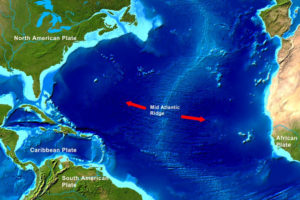The MidAtlantic Ridge is an undersea mountain system. It sits on the boundary between the North American and Eurasian tectonic plates. This is the case in the North Atlantic. However, in the South Atlantic the ridge sits between the South American and African plates. The North American and Eurasian plates are moving away from one another. The same thing happens in the South Atlantic. This divergence builds the ridge and new ocean floor.
Origin of the MidAtlantic Ridge
Continental Boundaries

The MidAtlantic Ridge sits on the boundary of four continents. On both sides of the boundary, the continents are diverging – moving away from one another. The North Atlantic Ridge separates North America and Eurasia. South of the Equator, the South Atlantic Ridge separates South America from Africa.
The ridge is about 16,000 kilometers long and part of an even larger global mountain range. This global range is 40,000 kilometers long – the longest mountain range in the world. The peaks of the ridge are about 3 kilometers high. Sometimes, the peaks rise above sea level and form islands.
A Spreading Sea Floor
Magma from the Earth’s mantle rises up to the ridge. The rising magma reaching the ocean floor results in volcanic activity. This activity creates pillow lava which creates new sea floor. This results in sea floor spreading. The Atlantic floor spreads by about 2.5 centimeters a year. In this fashion, the Atlantic Basin grows as the continents drift apart.
Rift Valley
A rift valley runs down the ridge system. This is actually where magma reaches the surface. If the surface is below sea level, pillow lava is created. However, if the surface is above sea level, volcanoes and islands are created.
Reflections
Vocabulary
- divergence
- magma
- rift valley
Notes
- The MidAtlantic Ridge lies in the middle of the North and South Atlantic Ocean.
- The ridge lies on the boundary of tectonic plates.
- A rift valley runs down the ridge and is an area where new ocean floor is created.
Bibliography
- A Lithosphere Study Guide
- About the Surface of the Earth
- Plate Tectonics, The Geological Society.

